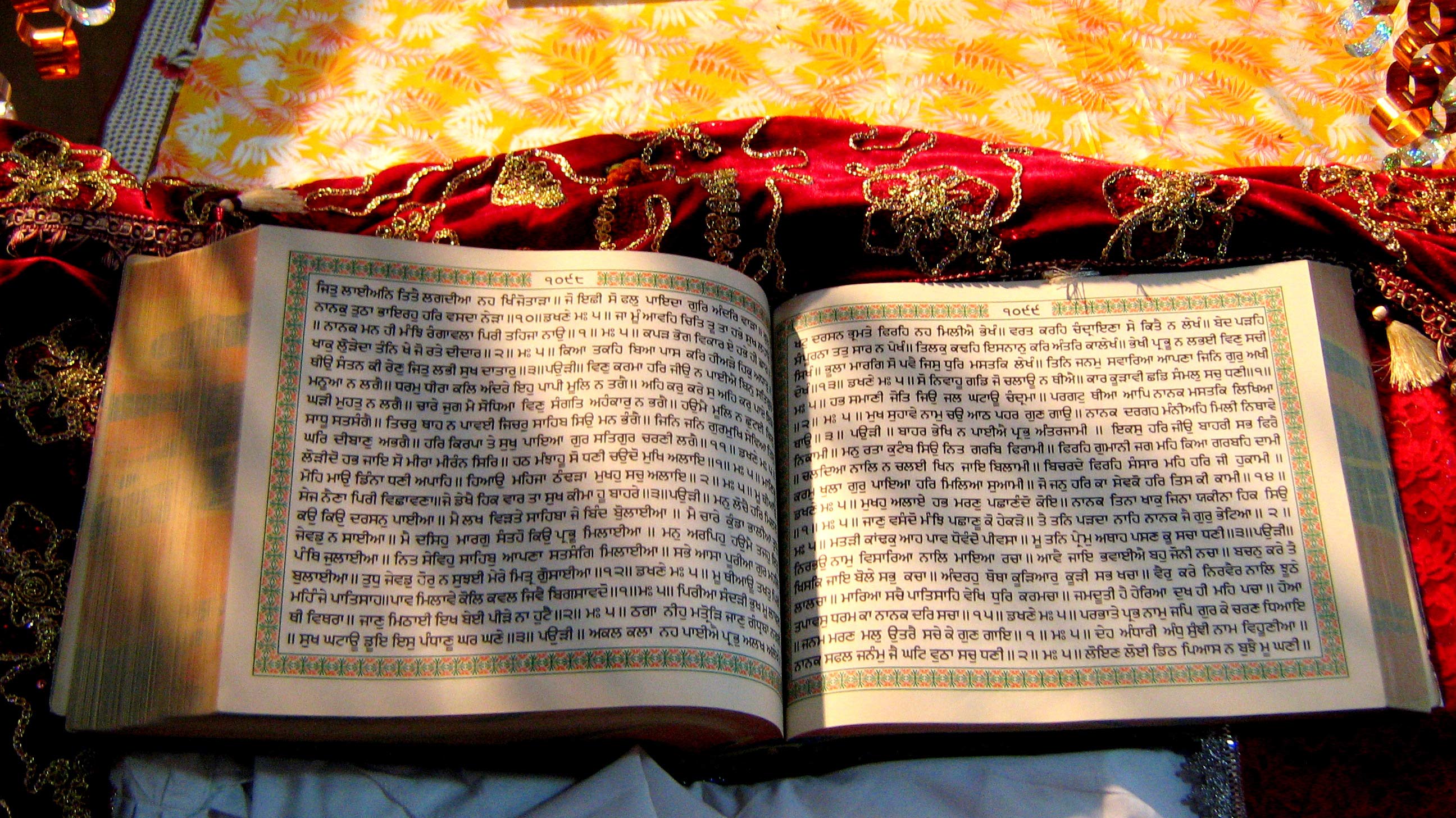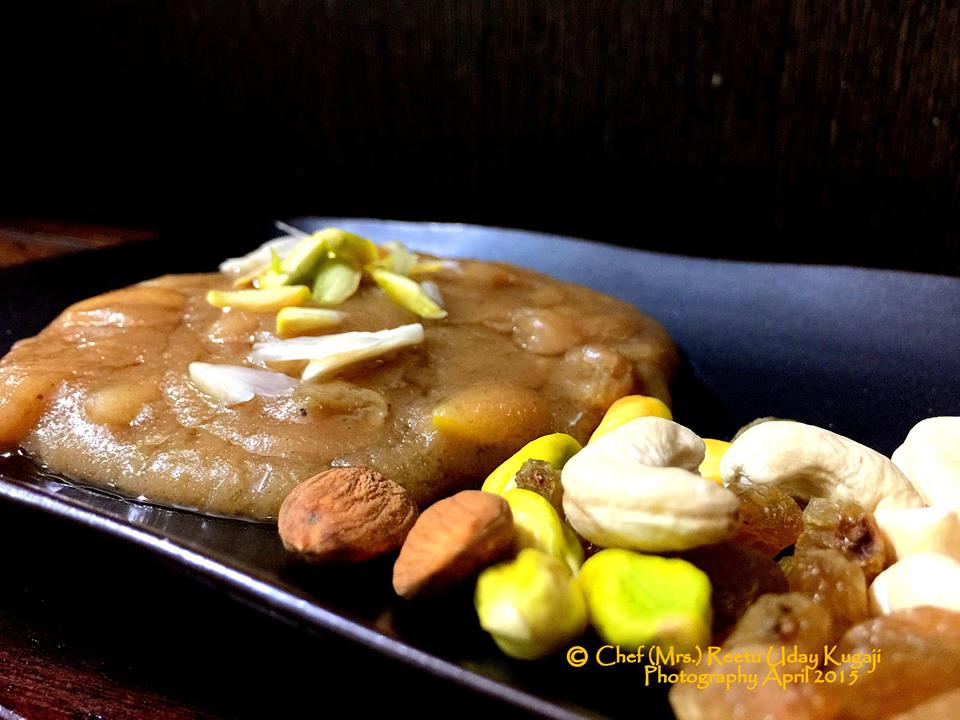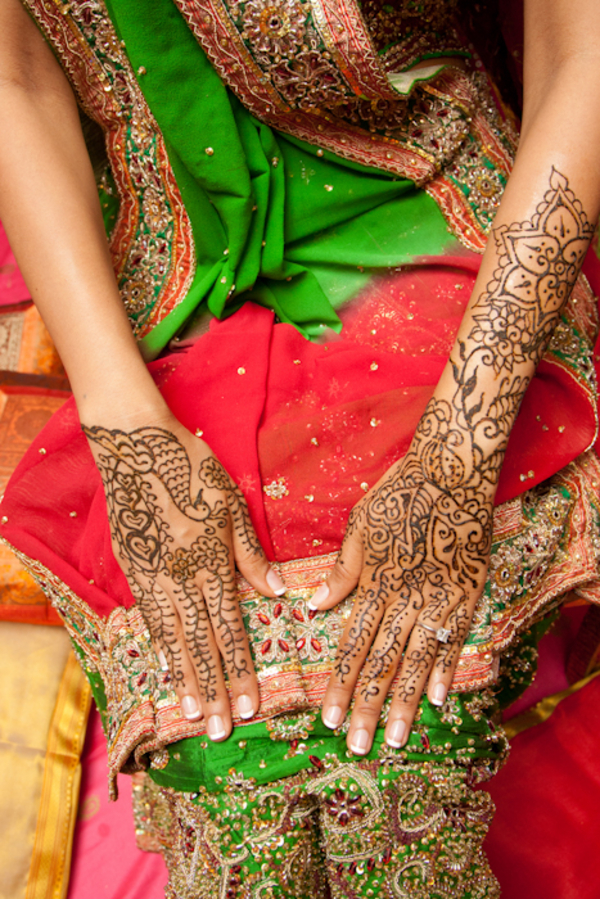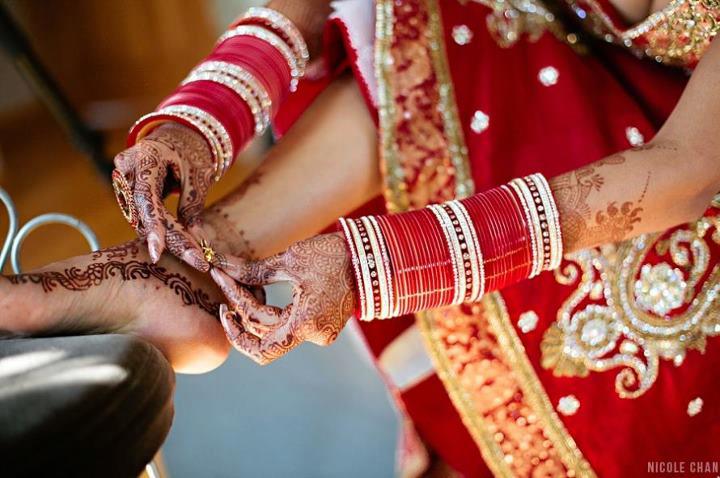After the formal intent to marry is declared by the bride and the groom, the pre-nuptial rituals begin.
Akhand Paath
Akhand Paath is the reading of the entire Guru Granth Sahib within 48 hours. The 1430 book must be read unbroken. A group of readers begin on a Friday morning and end on Sunday morning – usually the weekend before the official wedding, Anand Karaj, is fixed.
Photo via iphotopick.com
The family joins in as much as possible, otherwise offering meals and convenience for the undisturbed reading. The readers often do two hour stretches, rotating with usually four in the group. The reading is not interrupted by sleep, so it is often not done in a gurudwara and rather in a home.
The home in which the akhand paath is hosted must be cleared of all furniture and decorations. Clean white sheets are spread on the floor, and bouquets of fresh flowers are placed before the Guru Granth Sahib. Fruits or other offerings are not placed before the book – the arrangement is meant to be simple, and such offerings are considered unnecessary.
Both families hold this reading, so it must be planned in advance in order to avoid a clash. After the completion of the respective readings, a bhog celebration is held, where all family members are in attendance.
The importance of this ritual rests in the bride and groom’s understanding of the cultural responsibilities they are taking on via their marriage. Like all important Sikh life events like births or deaths, the Guru Granth Sahib embodies the tenets of the religion that must be held sacred every step of the way.
Kirtan
Kirtan is a musical performance of the holy texts, bani. At the Anand Karaj or wedding ceremony, and at some events prior, a group of three musicians – a tabla player and two harmonium – perform the music.
The players, or raagis, are treated with utmost respect, since they are describing holy scripture. Often times, the gurdwara that a couple is associated with or is hosting the wedding at will provide this musical group.
Ardas
The ardas is a supplementary prayer that is recited by Sikhs daily, often individually. Before the congregation of the wedding ceremony, the entirety of the guests at the wedding will recite these prayers together.
During this prayer, Sikh individuals follow proper etiquette, such as wearing head coverings.
Additional prayers, such as the vaak or hukam from the Granth Sahib scripture, may also be read during this time. These prayers are read by opening the book to a page at random and reading from the top of the right hand page.
Karah Prasad
After these prayers, a prasad of sweets, fruits, and nuts is offered. This food is sanctified by a prescribed method of preparation and is considered blessed and holy. Either the bride’s family cooks it, or it is made by the gurudwara.
The prasad is prepared with semolina flour, ghee, and sugar. It is a simple, easily digestible food that represents the grace of God.
Recipe via PioneerChef
The food served afterwards is from the guru’s kitchen – it is always vegetarian.
Shagan
The bride’s family visits the groom’s residence with the shagan, carefully wrapped gifts. These include saffron paste, a coconut broken in half, almonds, sugar, and dried fruits. The groom is formally welcomed into the family with a kesar tikka on his forehead and receives the gifts after. Mithai is also enjoyed by everyone.
Chunni Chadana
A few days before the wedding itself, the groom’s female relatives take an auspicious red chunni or outfit and jewelry gifts to the bride’s house. They present her with a red outfit to wear on the wedding date, along with perfume, makeup, and jewelry to dress herself up.
From Naureen & Ghazaly’s Wedding
This occasion represents good will between the two families and symbolizes the bride entering the groom’s family. The festive red color of the bride’s outfit is symbolic of the prosperous new life she is about to live.
Warna
In order to prevent the evil eye from presiding over the new marriage, family members wave money clockwise over the heads of the bride and groom. They also make donations to charity and ask for blessings from elders.
Sangeet
The sangeet is an important event to celebrate Sikh and Punjabi culture. Punjabi folk songs were methods of storytelling, passed down through generations. The wedding is celebrating by singing such songs and dancing with a new family.
Originally, the sangeet was only for ladies, as they sang and played music together. However, men now enjoy the modernized event of dancing, singing, and DJd music.

Bhangra is a popular Punjabi dance that is enjoyed especially during this event. The dancing often calls for the ceremony to be held in a big hall to accommodate guests and dinner as well.
Mehndi
On the morning before the wedding, the female relatives of the groom join the bride’s side at her home to apply henna to her hands and feet. The dry mehndi powder is provided by the groom’s family, along with some gifts for the bride.
Turmeric paste is also applied to the bride, as she cleanses the dried mehndi off her skin. This paste leaves her skin bright and glowing for the big day.
In some Punjabi families, the groom also celebrates the mehndi, in his own home. Instead of applying mehndi to his arms and legs, however, he simply applies turmeric paste to his face and arms to beautify himself for the ceremony. In this case, the groom dips his hands into the mehndi paste and then imprints them on a wall in his house – where he is to return only after he is married and head of the household.
Choora
After the bride rinses from the turmeric paste, she is gifted traditional red and white bangles by her maternal uncle. These bangles are worn for a few months after the wedding, symbolizing the status of newlywed. She usually wears 11 on each wrist.
Photo via bridalstores.wordpress.com
The chooras, bangles, are washed in milk before their wearing. The bride’s maternal uncle slips them on her wrist and blesses her. Sweets are then enjoyed all around.
The bride then begins to get ready in her wedding outfit for the official marriage ceremony. Her family bids her goodbye by tying strings dipped in saffron and turmeric on her wrists, symbolizing good fortune.
Wedding Invitations
The convention of sending out wedding invitations is very similar to Western practice. The paper invitations include the details for the bride’s and groom’s families, as well as the dates and locations of each of the events. Sometimes, the invitations are hosted by the elders of the families, to show respect.
Separate invitations are given for each event – such as the sangeet and mehndi, but they are often mailed together.
After the pre-wedding rituals, the Anand Karaj and other wedding day events formally begin.
Check out the rest of the series here:
Introduction
Pre-Wedding Rituals – You are here!





